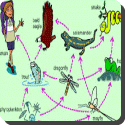 The sun is the driving force in all of the Earth’s processes. It is the sun’s rays that keep our planet warm enough for us to be able to survive, it is the weather’s motor, and provides energy for the most important process of all so far as plants and animals are concerned. The sun provides plants with the energy for photosynthesis. It is by photosynthesis that plants use the sun’s energy to convert carbon dioxide taken in from the air, and water from the soil into the sugars and starches that make up their stems, leaves, and roots. It is a little more complicated than this, and plants, need other substances as well but this is the important process. Photosynthesis only occurs in plants that contain the complex green pigment chlorophyll, in other words in green plants.
The sun is the driving force in all of the Earth’s processes. It is the sun’s rays that keep our planet warm enough for us to be able to survive, it is the weather’s motor, and provides energy for the most important process of all so far as plants and animals are concerned. The sun provides plants with the energy for photosynthesis. It is by photosynthesis that plants use the sun’s energy to convert carbon dioxide taken in from the air, and water from the soil into the sugars and starches that make up their stems, leaves, and roots. It is a little more complicated than this, and plants, need other substances as well but this is the important process. Photosynthesis only occurs in plants that contain the complex green pigment chlorophyll, in other words in green plants.
Other types of plants depend on other means of the planet’s life forms. You know that cows, for example, eat grass. Without grass or other plant material available, cows could not survive. We then make use of the cow’s ability to digest grass and convert into meat and milk which we eat and drink. Thus, the cow is a herbivore, that is, an animal that feeds on plants. When we eat meat, we are behaving as carnivores or meat eaters. This demonstrates a simple chain of events, in fact, it is known as a food chain. The grass grows and is eaten by the cow which is eaten by man.
There are many other such chains. A fox may feed on rabbits, which may be eating clover. The clover may be dependent not only on the sun, water, and the air, but also on bees for pollination. These chains can be disturbed quite easily sometimes with far reaching effects. For example, should bees become reduced in number for any reason, such as farmer using insecticides, in time the amount of clover would fall back and the rabbits might be forced to feed on the farmer’s lettuces. Obviously, the farmer will not be happy about this and may set about reducing the rabbit population. If he was too enthusiastic and all the rabbits in an area were to be wiped out, the fox would have to look elsewhere for its meals it might even be the same farmer’s chickens.
Try to imagine multiplying these simple chains thousands of times to take the multitudes of different animals and plants into account. Now you begin to have some idea of the complicated nature of life on our planet, how animals and plants depend upon their surroundings and each other, and how easily the balance can be upset.
 Kids Portal For Parents India Kids Network
Kids Portal For Parents India Kids Network






